June 4th, 2019
7 Ways to Track Your Language Learning
When you’re learning a language, it’s very easy to dive in head first and use all of the things to learn all of the words. And then end up feeling overwhelmed and stressed and confused because you don’t know as much as you’d hoped by now. We’ve all been there. One way around this? Tracking your progress. Here are 7 ways to track your language learning.

Why track?
When you track your language learning, you’re giving yourself a reference point. This means that if things ever do get too overwhelming and you’re doubting if you should carry on, you can take a look back over your tracking to see how far you’ve come.
This realisation that you are improving will either give you the motivation to keep going. Or you’ll discover you haven’t improved as much as you’d have liked and be able to adjust things going forward to make sure you do start to see improvements.
But what if you’re quite experienced with a language and not really looking to improve, but more so to keep going?
I run. And I like to do other sports too. There’s an app for sport tracking called Strava. I find it helpful and encouraging to see how I’m doing by using Strava as a way to track my activity.
I’ve not yet found quite the right app yet to track your language learning. (Although that’s something I’d LOVE to create in the future!)
However, The Solo Language Learner Planner does what I want when it comes to tracking language progress.
And besides, there’s a joy in having an aspect of life on paper and not pixels!
Calendars
I don’t know about you but when I’m feeling overwhelmed, I need a blank calendar page in front of me that I can gradually fill up (comfortably!) with what needs to be done.
Seeing everything on one page helps to create some clarity about what I want to do and when I want to get it done by.
With The Solo Language Learner Planner, you get an Annual Calendar, 6 Month Calendar, Monthly Calendar, and Weekly Calendar.
All of these are dateless, which, just like the rest of The Solo Language Learner Planner, is great for being used again and again.
Tracking your language learning on a calendar is one of the best ways to get started to ensure good progress.
Trackers
But how do you keep track of all that optimistic ‘adding things to the calendar’ and actually know that you’re doing the things? Habit trackers.
For many, this may simply involve marking the page to know you’ve done what you wanted.
However, I know that for some language learners (and for some habits), a little more reflection is best.
That’s why The Solo Language Learner Planner gives you not only simple Annual, Monthly, and Weekly Daily Habit Trackers, but also advanced Monthly and Weekly Daily Habit Trackers.

These advanced tracking pages give you space to make additional notes, consider what you enjoyed, didn’t enjoy, roadblocks to your habit, and more. Pretty cool.
Goal-Setting
But, hey, I get it. Maybe you know you want or need to start learning a language but you don’t really know where to begin, so adding things to a calendar and tracking them is kinda one step ahead right now. No worries, here’s where your Goal-Setting comes in.
As you may have guessed if you’ve ever read this or any Clear The List post here on the blog, I quite like goals.
Language goals help to give us direction, focus, and set attainable achievements and over the years, I’ve grown to find them crucial to my solo language study success.
When I don’t set them, I don’t do well. And when I do set goals? I get to where I want with a language.
However, depending on where we’re at with a language, there’s different approaches we might want to take when it comes to goal-setting.
The Solo Language Learner Planner has 2 First Impressions Goals pages – one for new language goals, and the other for current language goals for when we need a little redirection.
Beyond that, there’s 2 pages of language goal questions to help expand upon these First Impressions pages.
Next up are the Onion Goals and Ladder Goals, complete with full simple and advanced examples so you can see how they work in action.
Planners
Once your goals are established, it’s time to take action and make it happen!
The Solo Language Learner Planner includes both a Daily Planner and a Project Planner. The Daily Planner is great for daily study sessions. The Project Planner is helpful for short-term language projects to ensure continued progress.
At first, it might not seem that a planner is part of your tracking, but if you’re keeping your old planning pages then you can use them as reference points when it comes to revision of language down the line.
Reviews
One of the frequently ignored elements of successfully tracking your language learning is the review stage.
Not only does reviewing what you’ve done act as a nice bookend to something you’ve done, but it also works as an opportunity to figure out what might need changing going forward.
If we keep blindly working forwards without caring to pause and reflect, we’re doing ourselves a disservice as we’re not allowing a chance for improvement.
The Study Review page in The Solo Language Learner Planner works really well for a study session, a project, a regular check-in review etc.
Records
I don’t know about you, but sometimes I feel like I’ve done nothing for a language in ages. Boo!
Then when I realise how much I’ve been doing other stuff.
Listening to podcasts, watching TV or films, or reading in that language.
I realise that I’m actually doing ok and devoting a lot more time to that language than expected.
That’s why I added a whole new range of Record pages to this update of The Solo Language Learner Planner.
And of course, lessons and language exchanges are worth recording too. I’ve even included Lesson and Exchange Notes pages that you can use before, during, and after each session to help make the most of it.

As well as those records, it’s also a good idea to keep track of your skill practice (reading, speaking, and writing). Because, you know, that’s important too.
Deep Dives
Sometimes what’s really needed is a really focused session on a piece of content, vocabulary, grammar, or verbs. The Deep Dive pages in The Solo Language Learner Planner help you to do that, and keep track of it for future reference too.
Each Deep Dive page is a little different but all give you space to practice what you learn with space for sentences in context, and all have a quick review to assess how well you know what you just learnt and if it matters enough to be studied again.
But there’s differences.

The Content Deep Dive lets you to consider what you’re expecting from context, and list the new language you learn.
The Vocabulary Deep Dive gives you space to consider etymology, other languages, or other forms as well as a mind map of related vocab.
The Grammar Deep Dive is all about explaining things in a way you understand, noting exceptions, usage, and other language similarities or differences.
And finally, the Verb Deep Dive is a page to track your knowledge of verbs in different tenses! Of course, this one will be better suited to some languages more than others.
The Solo Language Learner Planner

As you might have guessed already, all the tracking and planning pages mentioned in this article can be found in The Solo Language Learner Planner.
The Solo Language Learner Planner now has over 30 pages to support you through your language study.
They can be used again and again. Printed or used digitally. And will help to create a better learning environment for your language study.
(Please note that some pages work better on paper than digitally, such as the onion goals. However, all have been made digital ready so you have the option.)
If you already have The Solo Language Learner Planner, no worries! You’ll get instant access to these updates and do not need to re-purchase the new version.
Don’t yet have a copy and want to boost your language learning? Click here to get The Solo Language Learner Planner now.







